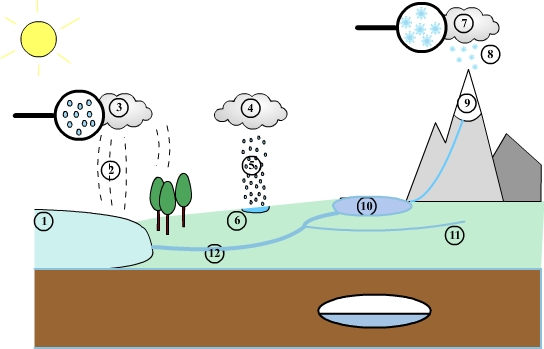
Chemistry
Learning physics
and chemistry
easily and freely - Science for elementary school, middle school and
high school
Free online chemistry lesson for elementary school, middle school and high school.
Water
The water cycle
The essential
about the water cycle
The water cycle explained
Water is present in nature under many different and temporary forms. All changes that may affect water in nature contribute to the water cycle.
Water cycle
diagram

( diagram: an example of water
cycle )
Steps of water cycleStep 1: Under the influence of Sun and winds, the water from oceans, seas (and all the reserves of liquid water in the open air) undergoes a vaporization.
Note: All trees and plants also produce water vapor (this phenomenon is called evapotranspiration).
Step 2: Water vapor, invisible to the naked eye, rises into the atmosphere.
Step 3: In contact with a layer of cold air, water vapor becomes liquid and forms clouds made of tiny water droplets.
Step 4: Pushed by the winds, clouds reach the inland.
Step 5: When the droplets that form the clouds become too heavy they finally fall and form a rain.
Step 6: Once on the ground, the water from precipitations may flows or it can also penetrate the soil (it infiltrates).
Step 7: At high altitudes, temperatures can become very low. The droplets that form clouds solidify to form ice crystals.
Step 8: When ice crystals combine to form heavier snowflakes, they fall and form some snow.
Step 9: If the snow falls on mountains high enough it can feed a glacier or forms a snowpack.
Step 10: Fusion of snow and glaciers gives birth to rivers that may join a lake.
Step 11: The groundwater fed by rainwater that infiltrates the ground may spray out at the surface as source that give birth to a river.
Step 12: The rivers flow into other rivers and finally reach a sea or an ocean.
Learn
more about water cycle
Kidszone: the water cycle explained to kids with worksheet to download.
The water cycle - Water science for school: The water cycle ( also called hydrologic cycle ) explained with a beautiful and detailed diagram.
Flash water cycle: animated flash water cycle that explains vapor, clouds, rain and water storage.
Earthguide - water cycle diagram: another animated diagram that shows how water moves in nature and its differents forms
South east water - water cycle game: an interactive game to learn different steps of water cycle

©2021 Physics and chemistry


